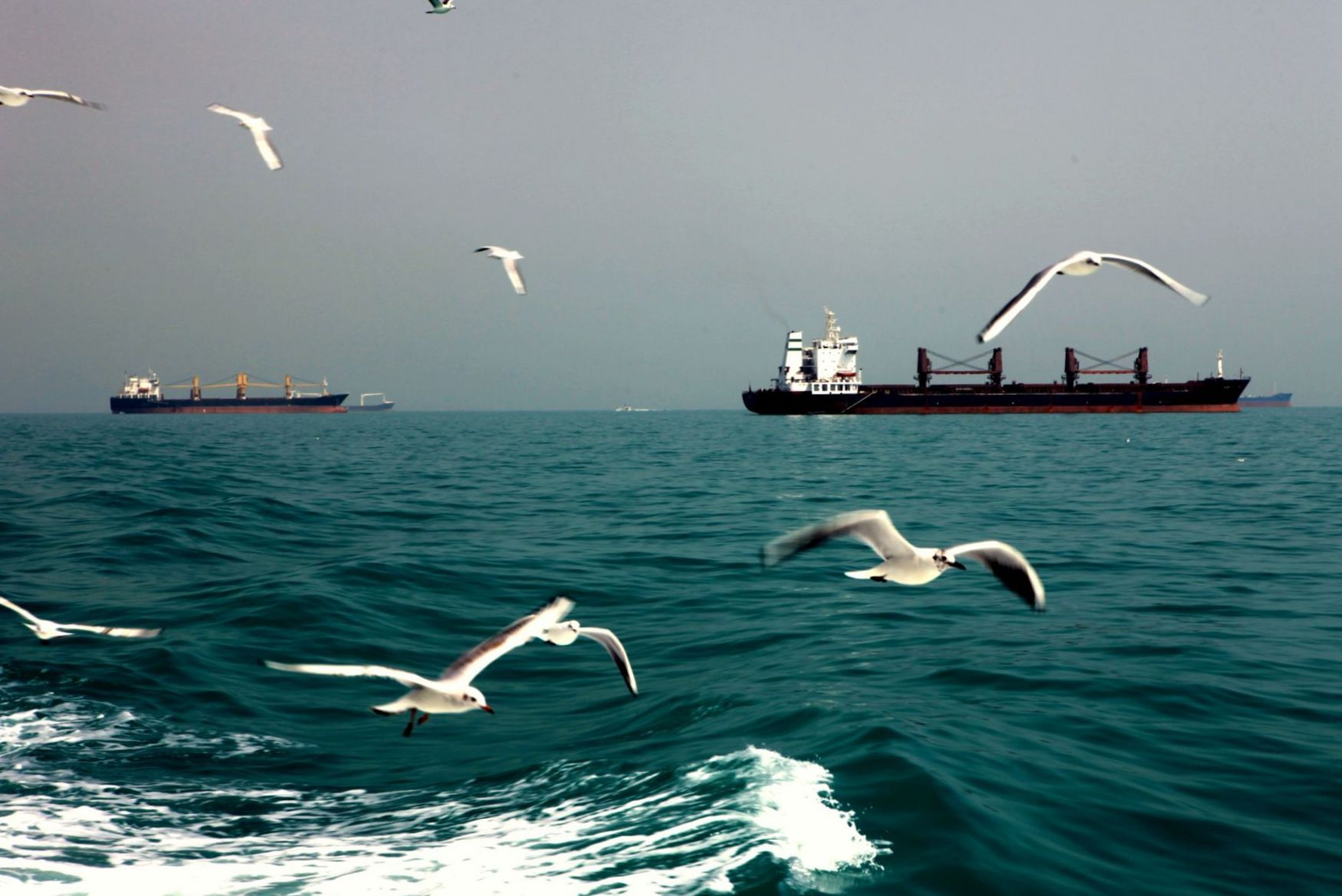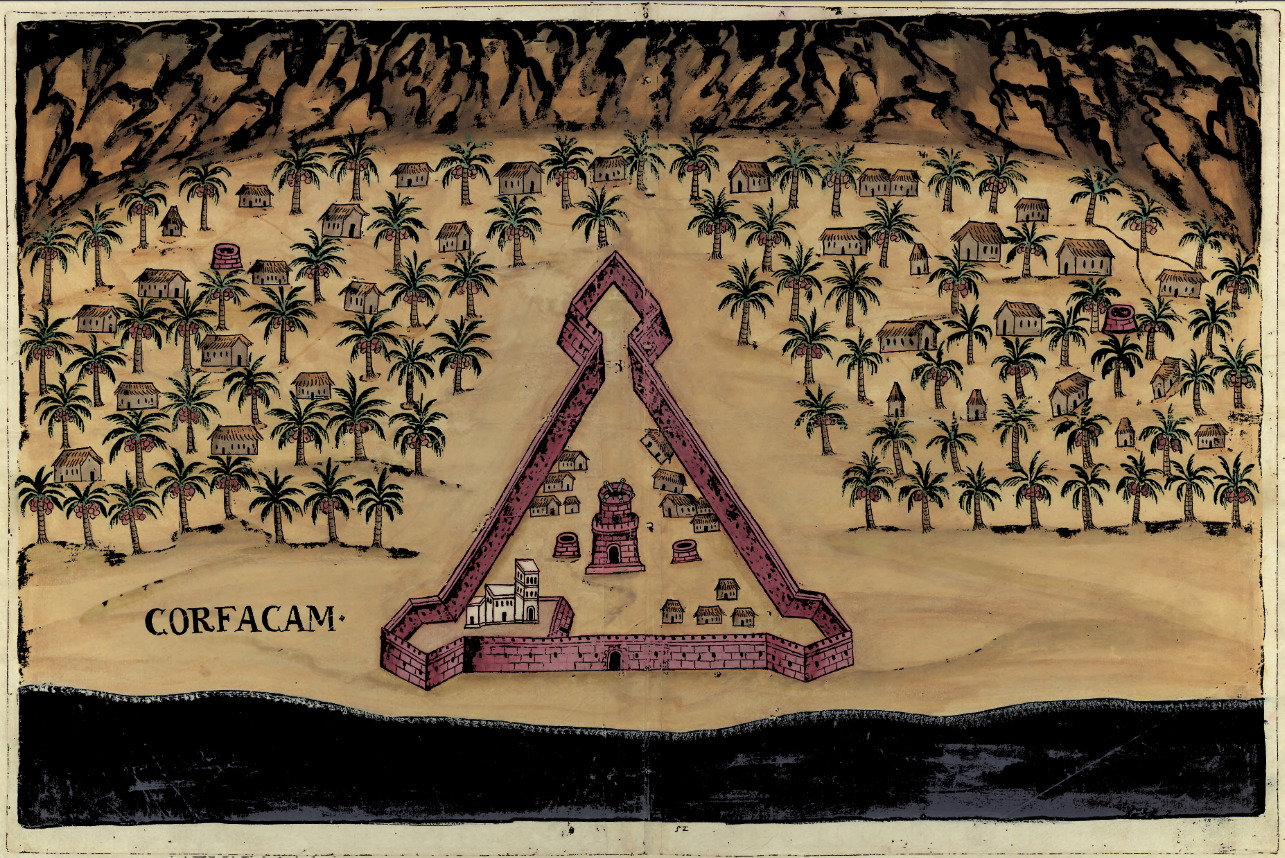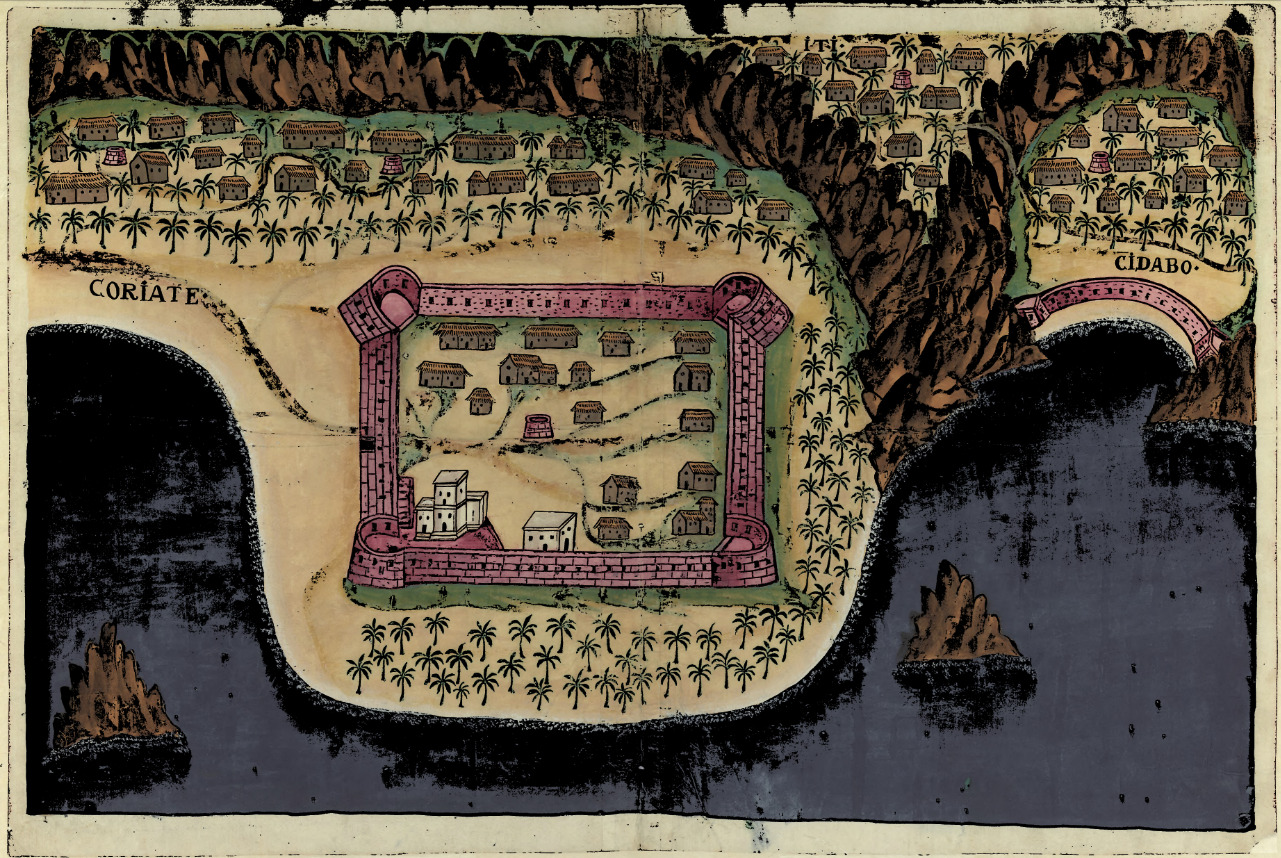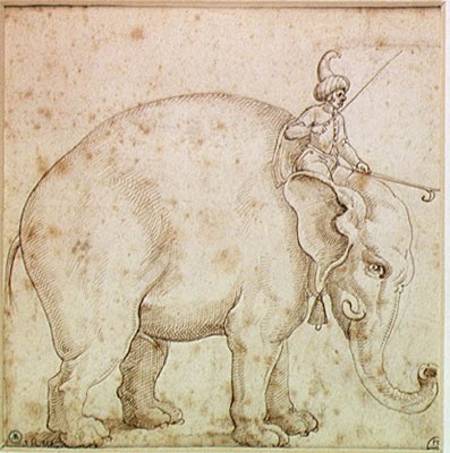|
Portuguese Conquest Of Ormuz
The Capture of Ormuz in 1507 occurred when the Portuguese Afonso de Albuquerque attacked Hormuz Island to establish the Fortress of Ormuz. This conquest gave the Portuguese full control of the trade between India and Europe passing through the Persian Gulf. Background The campaign against Ormuz was a result of a plan by King Manuel I of Portugal, who in 1505 had resolved to thwart Muslim trade in the Indian Ocean by capturing Aden to block trade through the Red Sea and Alexandria; Ormuz, to block trade through Beirut; and Malacca to control trade with China. The Portuguese had reports indicating that the island of Socotra was inhabited by Nestorian Christians and might prove useful towards this endeavor. Socotra was then a dominion of the Banu Afrar clan of Qishn, in mainland Arabia, whom the Portuguese would refer in the 16th century as ''Fartaques''. Thus, in April 1506, two fleets totalizing 16 ships, under the overall command of Tristão da Cunha, were dispatched f ... [...More Info...] [...Related Items...] OR: [Wikipedia] [Google] [Baidu] |
Hormuz Island
Hormuz Island (; fa, جزیره هرمز ''Jazireh-ye Hormoz''), also spelled Hormoz, is an Iranian island in the Persian Gulf. Located in the Strait of Hormuz, off the Iranian coast, the island is part of Hormozgan Province. It is sparsely inhabited, but some development has taken place since the late 20th century. History The earliest evidence for human presence on the island is several stone artifacts discovered at the eastern shorelines of the Island. A lithic scatter was found at a site called Chand-Derakht, which is an uplifted marine Pleistocene terrace. This site yielded a Middle Paleolithic lithic assemblage characterized by Levallois methods and dates back to more than 40,000 years ago. The island, known as Organa () to the ancient Greeks and as Jarun in the Islamic period, acquired the name of "Hormuz" from the important harbour town of Hormuz (Ormus) on the mainland 60 km away, which had been a centre of a minor principality on both sides of the strait. The ... [...More Info...] [...Related Items...] OR: [Wikipedia] [Google] [Baidu] |
Red Sea
The Red Sea ( ar, البحر الأحمر - بحر القلزم, translit=Modern: al-Baḥr al-ʾAḥmar, Medieval: Baḥr al-Qulzum; or ; Coptic: ⲫⲓⲟⲙ ⲛ̀ϩⲁϩ ''Phiom Enhah'' or ⲫⲓⲟⲙ ⲛ̀ϣⲁⲣⲓ ''Phiom ǹšari''; Tigrinya: ቀይሕ ባሕሪ ''Qeyih Bahri''; ) is a seawater inlet of the Indian Ocean, lying between Africa and Asia. Its connection to the ocean is in the south, through the Bab el Mandeb strait and the Gulf of Aden. To its north lie the Sinai Peninsula, the Gulf of Aqaba, and the Gulf of Suez (leading to the Suez Canal). It is underlain by the Red Sea Rift, which is part of the Great Rift Valley. The Red Sea has a surface area of roughly 438,000 km2 (169,100 mi2), is about 2250 km (1398 mi) long, and — at its widest point — 355 km (220.6 mi) wide. It has an average depth of 490 m (1,608 ft), and in the central ''Suakin Trough'' it reaches its maximum depth of . The Red Sea also has exten ... [...More Info...] [...Related Items...] OR: [Wikipedia] [Google] [Baidu] |
Parsi
Parsis () or Parsees are an ethnoreligious group of the Indian subcontinent adhering to Zoroastrianism. They are descended from Persians who migrated to Medieval India during and after the Arab conquest of Iran (part of the early Muslim conquests) in order to preserve their Zoroastrian identity. The Parsi people comprise the older of the Indian subcontinent's two Zoroastrian communities vis-à-vis the Iranis, whose ancestors migrated to British-ruled India from Qajar-era Iran. According to a 16th-century Parsi epic, ''Qissa-i Sanjan'', Zoroastrian Persians continued to migrate to the Indian subcontinent from Greater Iran in between the 8th and 10th centuries, and ultimately settled in present-day Gujarat after being granted refuge by a local Hindu king. Prior to the 7th-century fall of the Sassanid Empire to the Rashidun Caliphate, the Iranian mainland (historically known as 'Persia') had a Zoroastrian majority, and Zoroastrianism had served as the Iranian state religion ... [...More Info...] [...Related Items...] OR: [Wikipedia] [Google] [Baidu] |
Alexander The Great
Alexander III of Macedon ( grc, wikt:Ἀλέξανδρος, Ἀλέξανδρος, Alexandros; 20/21 July 356 BC – 10/11 June 323 BC), commonly known as Alexander the Great, was a king of the Ancient Greece, ancient Greek kingdom of Macedonia (ancient kingdom), Macedon. He succeeded his father Philip II of Macedon, Philip II to the throne in 336 BC at the age of 20, and spent most of his ruling years conducting a lengthy military campaign throughout Western Asia and ancient Egypt, Egypt. By the age of thirty, he had created one of the List of largest empires, largest empires in history, stretching from Greece to northwestern Historical India, India. He was undefeated in battle and is widely considered to be one of history's greatest and most successful military commanders. Until the age of 16, Alexander was tutored by Aristotle. In 335 BC, shortly after his assumption of kingship over Macedon, he Alexander's Balkan campaign, campaigned in the Balkans and reasserted control ... [...More Info...] [...Related Items...] OR: [Wikipedia] [Google] [Baidu] |
Khor Fakkan
Khor Fakkan ( ar, خَوْر فَكَّان, Khawr Fakkān) is a city and exclave of the Emirate of Sharjah, located on the east coast of the United Arab Emirates (UAE), facing the Gulf of Oman, and geographically surrounded by the Emirate of Fujairah. The city, the second largest on the east coast after Fujairah City, is set on the bay of Khor Fakkan, which means "Creek of Two Jaws". It is the site of Khor Fakkan Container Terminal, the only natural deep-sea port in the region and one of the major container ports in the UAE. The Port of Khor Fakkan faces the Emirate of Sharjah’s eastern seaboard, extending connections with Asia and the Far East. This port is one of the Emirate’s three ports. It is also a popular spot among domestic tourists due to its white sand beaches and coral reefs that attract many marine life enthusiasts. Khor Fakkan beach lies to the north of the center of the town. Khor Fakkan is located on the east coast of the UAE, between the Shumayliyah Mountains ... [...More Info...] [...Related Items...] OR: [Wikipedia] [Google] [Baidu] |
Sohar
Sohar ( ar, صُحَار, also Romanized as Suḥār) is the capital and largest city of the Al Batinah North Governorate in Oman. An ancient capital of the country that once served as an important Islamic port town, Suhar has also been credited as the mythical birthplace of Sinbad the Sailor. According to the 2010 census, Suhar's population was 140,006, making it Oman's fifth most-populated settlement. Described as an industrial town, the development of the Sohar Industrial Port during the 2000s has transformed it into a major Omani industrial hub. History As the largest town in the region, it has been argued that Suhar is identified with the ancient town called 'Omanah' ( ar, عُمَانَة) mentioned by Pliny the Elder in his '' Natural History''. This settlement is believed to have given Oman its name. According to Al-Tabari, in 893 or 894, during the Abbasid era, there was a dispute about who should rule Oman amongst local factions. A faction that approached the Abbas ... [...More Info...] [...Related Items...] OR: [Wikipedia] [Google] [Baidu] |
Eunuch
A eunuch ( ) is a male who has been castrated. Throughout history, castration often served a specific social function. The earliest records for intentional castration to produce eunuchs are from the Sumerian city of Lagash in the 2nd millennium BCE. Over the millennia since, they have performed a wide variety of functions in many different cultures: courtiers or equivalent domestics, for espionage or clandestine operations, castrato singers, concubines, or sexual partners, religious specialists, soldiers, royal guards, government officials, and guardians of women or harem servants. Eunuchs would usually be servants or slaves who had been castrated to make them less threatening servants of a royal court where physical access to the ruler could wield great influence. Seemingly lowly domestic functions—such as making the ruler's bed, bathing him, cutting his hair, carrying him in his litter, or even relaying messages—could, in theory, give a eunuch "the ruler's ear" and impa ... [...More Info...] [...Related Items...] OR: [Wikipedia] [Google] [Baidu] |
Muscat
Muscat ( ar, مَسْقَط, ) is the capital and most populated city in Oman Oman ( ; ar, عُمَان ' ), officially the Sultanate of Oman ( ar, سلْطنةُ عُمان ), is an Arabian country located in southwestern Asia. It is situated on the southeastern coast of the Arabian Peninsula, and spans the mouth of .... It is the seat of the Governorate of Muscat. According to the National Centre for Statistics and Information (NCSI), the total population of Muscat Governorate was 1.4 million as of September 2018. The metropolitan area spans approximately and includes six Provinces of Oman, provinces called . Known since the early 1st century Anno Domini, AD as an important trading port between the Western world, west and the Eastern world, east, Muscat was ruled by various indigenous tribes as well as foreign powers such as the Sassanid Empire, Persians, the Portuguese Empire and the Ottoman Empire at various points in its history. A regional military power in the ... [...More Info...] [...Related Items...] OR: [Wikipedia] [Google] [Baidu] |
Qurayyat, Oman
Qurayyat is a small fishing town 83 km southeast of Muscat, Oman, adjacent to the towns of Sur, Diman Wa Tayeen and Aamerat. A popular stopping point on the way to Sur, Qurayyat is in itself also a very popular destination for Muscat. On 28 June 2018, Qurayyat set the record for the highest daily "low" temperature ever recorded: 42.6 degrees Celsius (109 F). Climate of Qurayyat Given that the state is coastal, the humidity levels rise up to extremes especially in Summer, while mountains remain relatively lower levels of humidity, Al Jabal Al Aswad (The Black Mountain) is located in the inner parts of the state and it is known for extreme cold weathers in Winter and moderate heat in Summer. Qurayyats Icon Most states in Oman have an icon that generally represents the state (For example, Lemon Tree for Saham), and for Qurayyat it is the Capra, given that the animal's habitat is scattered across the mountains of Qurayyat and the connection between Capra and Qurayyat's ... [...More Info...] [...Related Items...] OR: [Wikipedia] [Google] [Baidu] |
Qalhat
The ancient city of Qalhat, or Galhat ( ar, قلهات) (in the map of Abraham Ortelius, it named as Calha), is located just over 20 km north of Sur, in the Ash Sharqiyah Region of northeastern Oman. Site description Marco Polo visited Qalhat in the 13th century, referring to it as Calatu. Ibn Battuta visited the city in the 14th century, noting that it had "fine bazaars and one of the most beautiful mosques." He further noted the mosque was built by Bibi Maryam and included walls of qashani. Bibi Maryam continued to rule Qalhat and Hurmuz after the death of her husband Ayaz in 1311 or 1312. Zheng He visited the city in the 15th century, referring to it as 加剌哈 (Mandarin: jia-la-ha; Cantonese: gaa-laat-haa). Qalhat served as an important stop in the wider Indian Ocean trade network, and was also the second city of the Kingdom of Ormus. By 1507 when it was captured by Afonso de Albuquerque on behalf of the Portuguese Empire, the city was already in decline as trade ... [...More Info...] [...Related Items...] OR: [Wikipedia] [Google] [Baidu] |
Oman
Oman ( ; ar, عُمَان ' ), officially the Sultanate of Oman ( ar, سلْطنةُ عُمان ), is an Arabian country located in southwestern Asia. It is situated on the southeastern coast of the Arabian Peninsula, and spans the mouth of the Persian Gulf. Oman shares land borders with Saudi Arabia, the United Arab Emirates, and Yemen, while sharing Maritime boundary, maritime borders with Iran and Pakistan. The coast is formed by the Arabian Sea on the southeast, and the Gulf of Oman on the northeast. The Madha and Musandam Governorate, Musandam exclaves are surrounded by the United Arab Emirates on their land borders, with the Strait of Hormuz (which it shares with Iran) and the Gulf of Oman forming Musandam's coastal boundaries. Muscat is the nation's capital and largest city. From the 17th century, the Omani Sultanate was Omani Empire, an empire, vying with the Portuguese Empire, Portuguese and British Empire, British empires for influence in the Persian Gulf and Indian ... [...More Info...] [...Related Items...] OR: [Wikipedia] [Google] [Baidu] |
Tristão Da Cunha
Tristão da Cunha (sometimes misspelled Tristão d'Acunha; ; c. 1460 – c. 1507) was a Portuguese explorer and naval commander. In 1499, he served as ambassador from King Manuel I of Portugal to Pope Leo X, leading a luxurious embassy presenting in Rome the new conquests of Portugal. He later became a member of the Portuguese privy council. 1506 voyage Da Cunha was born in Portugal, c. 1460. He was nominated as first viceroy of Portuguese India in 1504, but could not take up this post owing to temporary blindness. In 1506 he was appointed commander of a fleet of 15 ships sent to the east coast of Africa and off India. His cousin, Afonso de Albuquerque, was in charge of a squadron of five vessels in this fleet that subsequently detached. Their mission was to conquer Socotra Island and build a fortress there, hoping to close the trade in the Red Sea. They sailed together until they reached Mozambique. In the Mozambique Channel they found his friend Captain João da Nova stranded ... [...More Info...] [...Related Items...] OR: [Wikipedia] [Google] [Baidu] |








